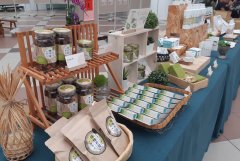Honey Bun cantaloupe variety specific, Honey Bun cantaloupe planting technology and growth management
Honey Bun is a true shrub cantaloupe, perfect for smaller gardens. Melons have deep orange flesh and honey sweetness. Each grapevine will produce 3 or 4 fruits.
Honey Bun cantaloupe seedlings appear 7-14 days after sowing, and once they appear, they can provide sufficient light on a sunny windowsill, or grow 3-4 cm every 3-4 hours under fluorescent plant lights and close for 8 hours at night. As the plants grow taller, raise the lights. Incandescent bulbs cannot be used in this process because they get too hot. Most plants need a dark period to grow. Don't leave the lights on for 24 hours.
According to the manufacturer, the seedlings do not need much fertilizer and use a screwdriver solution (half the strength of a complete indoor plant food) to eat at the age of 3-4 weeks.
Each pot is as thin as one plant. Seedlings need to "harden" before planting in the garden. Move young plants to outdoor conditions and move them outside to shelter for a week. Be sure to protect them from the wind and the hot sun. If frost is threatened at night, cover the containers indoors and take them out in the morning. This hardening process enhances the cellular structure of the plant and reduces the impact of transplantation and scald.
Sow seeds directly in the garden
Prepare the bed by turning the soil to a depth of 8 inches. Remove grass and stones horizontally with a rake.
After the danger of frost, sow in rich, warm soil.
Sow 3-inch seeds in 4-6 groups. Cover with 1 inch of fine soil.
The space group is 4-6 feet apart in each direction.
Keep moist evenly.
The seedlings appeared in 7-14 days.
When they were 1-2 inches tall, there were three to four of the strongest seedlings in each group.
How to grow? Maintain weed control during the growing season. Weeds compete with plants for water, space and nutrition, so they are controlled by regular cultivation or use of mulch to prevent their seeds from sprouting. Melons have shallow roots, and mulch helps to maintain soil moisture and uniform soil temperature.
Keep plants fully watered during the growing season, especially during droughts. During the growing season, plants need about 1-2 inches of rainfall a week. Use a rain gauge to check if water is needed. It is best to use a drip or drip system to transport water under low pressure at the soil level. If you are watering with elevated sprinklers, water them earlier in the day so that the leaves have time to dry before evening to minimize disease problems. Keep the soil moist but unsaturated.
As the plant grows, cover to control weeds, keep the fruit off the ground and keep moisture.
Don't move the grapevines, they are easy to get hurt.
To prevent disease, put the melon on the ground.
Monitor diseases and insect pests. Please consult your local cooperative extension service center to learn about the recommended pest control measures in your area.
Harvest and preservation
Let your melons ripen on grapevines. Generally speaking, when the fruit is ripe, they smell the fragrance, and when the stem begins to crack, the fruit is easily slipped by the slight pressure of the thumb.
Cantaloupes are harvested when the fruits change from green to yellow or brown, and they fall off easily from the grapevines.
The wax gourd is harvested when the wax gourd changes to the appropriate color and their blossoms and fruits are soft.
When the skin turns creamy yellow and the flowers are slightly softer, the melon ripens. To avoid damage, cut the honeydew off the grapevine with sharp scissors.
When the bottom of the watermelon changes from white to milky white, the watermelon is ready to be harvested. The tendrils closest to the fruit will also turn brown and dry, and the skin will become dim and hard at harvest.
Eat at room temperature for the best taste.
Melons can be stored in the refrigerator for a short time. If they are stored for too long, they will lose their taste and color.

- Prev

From the habitat of water pheasant to see the state of agricultural conservation environment, the crisis brought by population aging is very big
In March this year, media reports pointed out that some green energy operators persuaded farmers to lease farmland in Guantian area as a site for installing solar photovoltaic panels, offering a rent of 40,000 yuan a year higher than the market rent price (6000 yuan a minute) for a lease of 20 years to attract farmers to join; some
- Next

Taiwan Ma Dou Farmers' Association set up a stall at the Hong Kong International Food Fair for the first time, and Wendan processed products were in the vanguard.
Change into new clothes, which is refreshing! The farmers' association of Madou District of Tainan City changed its new clothes for its Wendan series of products and made its debut on the 2nd. The outer packaging is not only a new design, but there is also a new formula inside. Sun Cimin, general manager of Madou District Farmers' Association, said that the new formula of pomelo flower series products has more.
Related
- A course of planting techniques and methods on how to grow carrots
- How to plant the latest tulips?
- Is it better to pick tea in the morning or in the afternoon? When is the best time for tea to be picked? what is the third or fifth tea?
- Launch Yuanxiao Happy combination Haocha + Tea Yuan healthy Taste
- Penghu Tourism "Fireworks 20 Parade with You"
- 2022 West Lake Happiness holds "Digital Revitalization Voucher" and draws iphone13 and laptop.
- Banqiao Fuzhou social houses are designed to change start-up combined with police elimination to create a safe and livable environment
- The convenient measure of "mechanical weeding" in Xinbei has been abused and the Agriculture Bureau has imposed heavy penalties on the illegal land consolidation.
- Changgeng University Joins Hands with Four Memory Factories to Rescue Memory Talent Shortage
- The list of Taiwan's top 100 MVP managers is listed by the Director-General of the Farmers' Association of Sanxia District.

